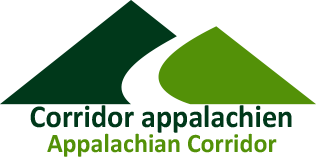
18 Nov THE NITOSLAWSKI-ROMER FAMILY DONATES 13.7 HECTARES FOR PERPETUAL PROTECTION IN BOLTON-EST

Membres of the Nitoslawski-Romer family (left to right): Klara, Clément, Marielle, Thérèse and Marek, joined by Françoise Bricault from CVS at a recognition ceremony to celebrate their ecological gift.
Bolton-Est, Quebec (November 18, 2020) – Conservation des vallons de la Serpentine (CVS) and Appalachian Corridor are pleased to announce the protection in perpetuity of a new property of nearly 14 hectares in Bolton-Est. This newly perpetually protected natural environment is made possible, above all, thanks to the generosity and commitment of the Nitoslawski-Romer family who recently donated the land which they enjoyed for more than five decades.
“The donation of this land for perpetual conservation is a great gift to offer our family, the community, and future generations,” expressed Mrs. Thérèse Romer, who acquired the property with her husband at the end of the 1960s for their benefit and that of their five children.
Located near Chemin Bellevue in Bolton-Est, the property is an addition of great ecological value to the growing network of protected areas on CVS’ territory. Located in the heart of the Mont Chagnon massif, the land is strategic with its wetlands and bodies of water that are favorable habitats for amphibians and reptiles including the wood tortoise, which is designated vulnerable in Quebec, as well as the marsh frog which is likely to be designated as threatened or vulnerable.


Marsh frog and wood tortoise. (Tortoise photo by Marc Lepage)
Appalachian Corridor’s biologists also found on the property a diverse avian fauna comprised of 32 listed species, nine of which are considered a priority by the Canadian Wildlife Service. These are the white-throated sparrow, the tree swallow, the collared warbler, the black-throated warbler, the blue warbler, the crowned warbler, the Canada warbler (endangered species in Canada), the black-and-white warbler, and the blue-capped vireo.
 Blue warbler.
Blue warbler.
“As part of the assessment process we underwent to perpetually protect the land, we were fascinated to learn a lot about the ecological diversity of the property,” explained Marek Nitoslawski, son of Mrs. Romer and heir of the property with his brother Stefan, and their sisters Jola, Anna and Marielle, following the death of their father in 2012. “We are happy to know that our donation will have a significant and immediate impact on these species and will contribute to the consolidation of an ecological corridor in the region.”
The Nitoslawski-Romer land will be under the care of CVS who is Appalachian Corridor’s local conservation partner. To date, CVS oversees 361 hectares of perpetually protected land.
“CVS is grateful for the great generosity of the Nitoslawski-Romer family,” commented Joe Marino, President of CVS. “By protecting the natural environments of our region in perpetuity, we ensure an environment conducive to the health of our ecosystems and also that of our community.”
In addition to maximizing positive long-term ecological impacts, the Nitoslawski-Romer’s gift has been recognized by the Government of Canada’s Ecological Gifts Program. This program offers considerable tax advantages to owners who choose to invest in the protection of biodiversity.
“The Nitoslawski-Romer family is doing an exemplary gesture for nature today, and one that will pay off forever; This is what is so extraordinary in conservation,” rejoiced Mélanie Lelièvre, Executive Director for Appalachian Corridor.
“Our entire team has been very happy to accompany the family on this journey of ecological giving,” she adds. “This land will complement the large conservation initiative we are developing spanning from southern Vermont to north of Mont Orford. In the Quebec portion of the Green Mountains, 14,459 hectares are now protected forever. We hope that their initiative will inspire others to contribute to this vision of protecting a large natural corridor of the territory.”
Appalachian Corridor thanks the following financial partners for their contributions to the successful completion of this project: the Fondation de la faune du Québec through the Protéger les habitats fauniques program, Environment and Climate Change Canada through the Habitat Stewardship Program for Species at Risk program, the U.S. Fish and Wildlife Service, and the Echo Foundation.
CLICK HERE TO READ THE DONOR PROFILE FOR MORE ON THE FAMILY’S JOURNEY.
ABOUT
Protéger les habitats fauniques program by the Fondation de la faune du Québec
The Protéger les habitats fauniques program by the Fondation de la faune du Québec aims to support high value habitat protection initiatives through the settlement of legal conservation agreements with private landowners. fondationdelafaune.qc.ca
Habitat Stewardship Program for Species at Risk by Environment and Climate Change Canada
Created in 2000, the Habitat Stewardship Program for Species at Risk program allows the financing of projects that contribute directly to the objectives related to recovery objectives and population goals of species at risk listed on Schedule 1 of the Species at Risk Act (SARA) and prevent others from becoming a conservation concern. canada.ca
Conservation des vallons de la Serpentine
CVS was born out of common values in the neighborhood and a collective desire to protect an area rich in natural environments and species. Today, more than 60 members support the cause and allow CVS to grow. This commitment is unique and is reflected in particular in an annual party, a must, which brings together people sensitive to environmental issues. CVS protects some 350 hectares of land, more than half of which belongs to it in title. The other part consists of conservation easements granted to it by private owners. All of these lands are protected in perpetuity. conservationserpentine.org
Appalachian Corridor
Appalachian Corridor is a non-profit conservation organization founded in 2002 with a mission to protect natural areas in the Appalachian region of Southern Québec. Through the implementation of a cross-border conservation strategy, Appalachian Corridor works with local communities to maintain and restore a way of life that respects the ecology of the region from a perspective of sustainable development. To date, Appalachian Corridor and its 17 members have allowed the perpetual protection of 14,459 hectares on their territory of action. corridorappalachien.ca
For more information, contact:
Marie-Hélène Thibeault
Communications and philanthropy coordinator
Appalachian Corridor
579-488-6670
www.corridorappalachien.ca
Françoise Bricault
Secretary-Treasurer
Conservation des vallons de la Serpentine (CVS)
450-297-2004
www.conservationserpentine.org/

